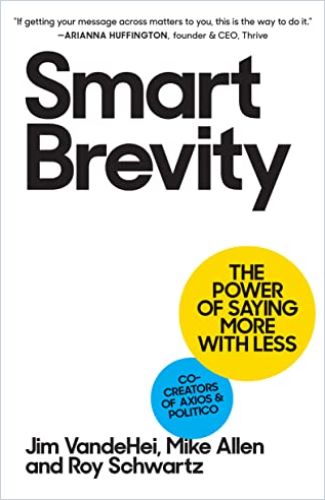Readers and listeners want concise, simple communications. The founders of news website Axios offer a proven system for writing short, sharp content that gets noticed, read and remembered.

Keep It Simple
People consume media and information differently than they did a decade ago. Subjected to countless distractions and a constant stream of content, their attention has become increasingly fractured, as well as a valuable commodity, for which content producers, advertisers and tech giants compete. Yet, for the most part, the delivery of content hasn’t bent to changes in consumption patterns.
Less Is More
But as preferences for consuming content shifted, the people at news site Axios were paying attention. Axios’s founders created a new approach for presenting information in the Age of Attention. This system for writing sharp, short, easily digested and compelling content, while preserving important details and nuance, came to be called Smart Brevity.
People are busy and have expectations of the precious time they give you. All they usually want to know is what’s new and why it matters. Give them that.Jim VandeHei, Mike Allen and Roy Schwartz
Journalists Mike Allen and Jim VandeHei, now Axios’s executive editor and CEO/chairman, respectively, along with digital media and strategy expert Roy Schwartz, the company’s president, sowed the first seeds of Smart Brevity when the trio was working at media site Politico, writing a subscription newsletter aimed at businesses and lobbyists. After a few years, a survey of readers showed only 5% wanted to read long stories. On the basis of this insight, the three quit Politico to found Axios: a news site designed to satisfy the demand for brevity. Axios launched in mid-2017, and in 2022, Cox Enterprises paid $525 million to acquire 70% of the company.
Readers First
The authors highlight the importance of prioritizing the audience’s needs: tailoring messages to supply precisely the information readers and listeners most need. The Smart Brevity approach conveys that content in strong words and simple phrases, eliminating redundancies and fluff. The authors’ Smart Brevity approach has four main components: the tease, the lede, context and an element of choice. These components can apply to any medium or platform, and all four should fit within the frame of a single smartphone screen.
The tease grabs people’s attention in six words or fewer of terse, striking language. The tease might take the form of a headline, a tweet or an email subject. It must cut through the reader’s distractions, grab attention and pique curiosity – for example, “Musk’s next move” or “Start-ups mining cash from trash.” Research indicates that most people spend an average of 26 seconds looking at a piece of digital content, so the first few seconds of engagement are critical.
In a world full of noise, people reward you if you respect their time and intelligence. This truth is universal.Jim VandeHei, Mike Allen and Roy Schwartz
The opening sentence, called the lede, should be direct, clear, concise and memorable, the authors say. Use it to tell people something novel or something they need to know. It should encapsulate the essence of the content. A precise, meaty lede conveys the importance of the message and entices people to keep reading. To write a lede, imagine you’re trying to convey a message to a friend who’s rushing out the door; that is, cut the throat-clearing and the niceties, and get right to the point.
Context and Choice
Context helps readers understand why they should care about your message. Journalists refer to a paragraph or sentence that distills a story’s significance as a “nut graf,” but they often bury this passage deep within a story. According to the Smart Brevity system, this text should follow the opening line. It shouldn’t repeat the content of the lede, the authors say; instead, it provides perspective.
Context enables readers to decide quickly whether to read further. Enter the element of choice in Smart Brevity: Once readers have learned the essence of the message, give them the option to learn more by continuing to read or clicking a link. On the Axios site, each story has a “Go deeper” button that links to a lengthier article.
Don’t be fancy – be effective.Jim VandeHei, Mike Allen and Roy Schwartz
After presenting the Smart Brevity system, the authors explain how it can enhance practically any communication: social media posts, speeches and presentations, and meetings. In each case, directness, clarity and strong, pithy language combine to make messages compelling and memorable. The authors give specific recommendations for preparing content for various platforms, as well as for speeches, presentations and meetings.
Making Your Words Work Hard
The authors recommend writing clearly and concisely to allow your readers to absorb your key points quickly. Use one-syllable words when you can, and choose concrete nouns. Cut weak words, especially those you wouldn’t use in casual speech. Avoid using specialist or erudite language that people use only in certain bubbles. For example, don’t write “discourse” when most people would say “talk.” Avoid vague words, such as “could,” “might” and “may,” and choose active rather than passive verbs. Make your phrases brief, punchy and crisp. After crafting your opening sentence, examine whether you could pare it down by a syllable.
Building Trust and Transparency
In a final chapter, the authors offer deeper reasons for embracing Smart Brevity within organizations: They argue that this approach can bring transparency, alignment and inclusivity to a corporate culture. Transparency demands clear, crisp, forthright communications, they say, and the secretive, cluttered communication styles of the past are becoming obsolete. The Smart Brevity approach, they argue, improves clarity, reducing uncertainty – and the gossip that accompanies it. It supports leaders in building trust, creating alignment with values and strengthening relationships with all stakeholders.
Complexity confuses. Abstraction alienates. Length loses.Jim VandeHei, Mike Allen and Roy Schwartz
The authors make the case that the Smart Brevity philosophy promotes inclusivity within a corporate culture via its clarity and directness, which help make messages accessible to people of diverse backgrounds, educational attainment and learning styles. And cutting redundant words, they say, means eliminating irrelevant references to people’s appearance, ethnicity or disability.
The popularity of the Axios news site demonstrates the power of the Smart Brevity approach, which Allen, VandeHei and Schwarz infused into their book. For anyone looking to boost the impact of their written and spoken communications, Smart Brevity offers a complete tried-and-tested system.












